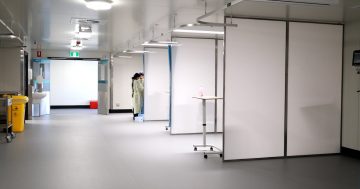
Operations team leader Rebecca Hundy has worked as a health practitioner for 20 years before joining ACT Health. Photo: Region Media.
ACT Health did not exceed more than a quarter of its surge capacity at the peak of the COVID-19 pandemic, which occurred when 11 cases were confirmed on 22 March.
Around 100 health workers and students were trained up by ACT Health to become contact tracers in preparation for an exponential increase in cases, but only 10 to 15 case liaison officers and the same amount of contact tracers were needed.
Plans are also in place for Australian Defence Force (ADF) personnel and seconded health staff like ambulance officers to be pulled in if the number of COVID-19 cases explodes in the ACT.
Operations team leader Rebecca Hundy says there are common misconceptions about contact tracing work, as staff often get grouped under the umbrella term ‘contact tracers’, but this only constitutes the final part of the process.
The foremost responsibility of a case liaison officer is to inform a patient that they have tested positive to COVID-19. Having to deal with the patient’s emotional state over the phone can be tough, according to Rebecca.
“We have to deal with their emotional state after telling them that they have tested positive, and then carefully ask them questions about their movements when they were contagious,” she told Region Media.

The number of daily COVID-19 cases in the ACT. Photo: ACT Health.
“Sometimes we will talk to them multiple times a day, or over several days, because people remember movements at different times,” Rebecca says.
“We tell them to go through their diaries, calendars and even bank statements to see if they remember anything else about who they might have been in contact with.”
The difficulty of contact tracing – and the challenge of a confirmed COVID-19 case remembering their movements and interactions with strangers – is the reason the National Cabinet endorsed the COVIDSafe app.
A health practitioner for two decades, Rebecca says most officers have a health background that helps them deal with the patient on an emotional level. Social workers and psychologists are also embedded in the teams to ensure they are able to effectively help any patient that becomes overly distressed at the news.
The scalable teams of case liaison officers and contact tracers mean that ACT Health can rapidly expand its capacity to handle the virus, and contingency teams to take over if anyone in the department had to be quarantined.
The health emergency control centre, or HECC, was first created six months ago in November to help manage and advise on the health implications of the extensive smoke that blanketed Canberra and the ACT from the black summer bushfires along the South Coast and East Gippsland in Victoria.
Deputy Health Controller Paul Cortese has experienced the physical and mental taxation a sustained emergency and crisis response can have on team members who can consistently work in excess of 12 hour days.
Paul was seconded as a liaison officer to NSW for the ACT Emergency Services Agency (ESA) during the bushfires before coming back to join the pandemic response in Canberra.
“It can be hard to wind down,” Paul said. “I usually use the hour drive in the car to listen to something and wind down.
“But you can have broken sleep because you wake up and have a thought bubble and come in early to work on it. I was in a bit early this morning because of a thought.”
Now that the situation in the ACT is under control, two teams work on four-day shifts across a seven-day roster within each centre. This ensures that not only are the same people in contact across the different teams, but the staggering also reduces physical contact people overlapping shifts.
Days have now reduced to a normal eight hours, but preparation continues for the worst-case scenario as game plans are drawn up for different departments tackling different scenarios.
What if there is an outbreak on a bus? What if a healthcare worker spreads the virus within an aged care facility? What if a contact tracer brings the virus to work? These are some of the scenarios planning officers prepare for every day.



















